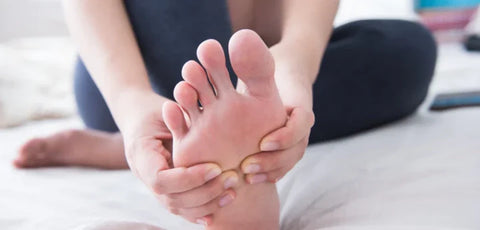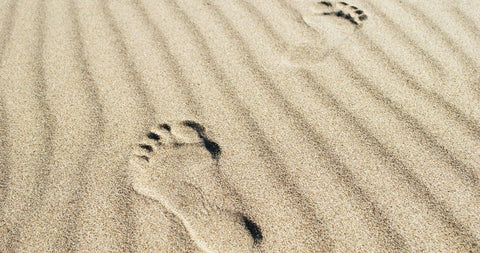
How to tackle cracked heels and dry feet
Whether you’re looking to bare it all on the beach or you want to feel comfortable in your favourite walking boots, dry feet can put a stop to your plans. Not only can cracked heels and dry skin put you off going barefoot, they can also be a major cause of irritation. Treat dry, itchy and sore feet early to avoid complications and enjoy wearing the shoes you love.
What causes dry skin on your feet?
While there’s no one factor that causes dry skin, there are a few different things that can contribute. For example, you might notice that the skin on your feet gets dry when it’s very hot or very cold outside.
Some people are also naturally more likely to have dry skin and find that the problem persists year-round. Dry skin can also be caused by ageing, psoriasis and eczema as well as some medical conditions and medications. The shoes you wear can have an effect, too. Spending a lot of time in sandals can lead to drier skin, as can wearing shoes that don’t fit properly.
Why do heels tend to crack?
When the skin on your feet is very dry, it may lead to cracking. This typically happens around the heel, where the skin tends to be thicker and callused. The biggest cause of heel cracking is a lack of moisture. The skin around your heels has a relatively small number of sweat glands and is less elastic than skin elsewhere, this means it’s prone to becoming dry or chapped.
Your heels are under a lot of pressure when you walk or stand, and this can cause dry skin to crack. There are also some conditions that can cause or contribute to cracked heels, including athlete’s foot, psoriasis, eczema, thyroid disease and diabetes.
Are cracked heels and dry skin a problem?
Having dry skin on your feet, or even some minor cracking on your heels, isn’t necessarily a problem. However, cracked heels can worsen and develop into fissures, leaving you vulnerable to dirt and infection. This is especially dangerous if you have an existing condition, like diabetes.
How can I make cracked heels look better?
Cracked heels or dry skin can also leave you feeling self-conscious, especially during the summer months when your feet might be on display. Smoothing and softening the skin on your feet and heels can leave you feeling more confident and comfortable.
Ways to treat dry feet and cracked heels
Use a thick moisturiser
One of the best treatments for dry skin and cracked heels is to use a nourishing moisturiser, like the Scholl’s Cracked Heel Repair Balm. This soothing moisturiser softens and hydrates, helping the skin on your heels soften and grow more flexible. This can help stop cracks from forming and gives existing ones the chance to heal.
Our balm has been formulated to smooth and fill heel cracks and soothes irritated and inflamed dry skin. It leaves a rich, moisturising layer of protection and contains urea, lavender, peppermint oils, shea butter and Epsom salts – so it feels and smells great.
Remove callused skin
You can also treat cracked heels by exfoliating thick calluses with the help of a pumice stone or a file. Removing layers of thickened skin help stop it from cracking, meaning you’ll be less susceptible to cracked heels and associated problems.
Our easy-to-use Scholl’s Nano Foot File exfoliates and smooths rough, dry and callused skin in no time. Before using a pumice stone or file, be sure to give clean and dry your feet. Gently remove hardened skin using a file or pumice stone once or twice a week and be sure to moisturise afterwards.
Keep feet clean and dry
Keeping your feet clean can also help to prevent cracked heels but do be sure not to overdo it. Using harsh soaps or scrubbing too hard can exacerbate the problem. Likewise, if you spend a lot of time with your feet in water, you may end up stripping the skin of its natural oils. This can leave it rough, dry and chapped and more vulnerable to cracking.
Wear properly fitting shoes
Making sure that you’re wearing shoes that fit properly can help prevent cracking. Ill-fitting shoes can rub or cause extra pressure on the heels. Open-back sandals or shoes can also allow fat under the heel to expand sideways, which increases the possibility of cracked skin. Likewise, regularly walking barefoot can cause calluses to develop which can worsen problems with cracking.
Looking after your feet
Taking care of your feet on a regular basis is one way to reduce the likelihood of dry skin, cracked heels or other common complaints. School foot creams and foot masks can help keep your feet soft and moisturised all year round.
